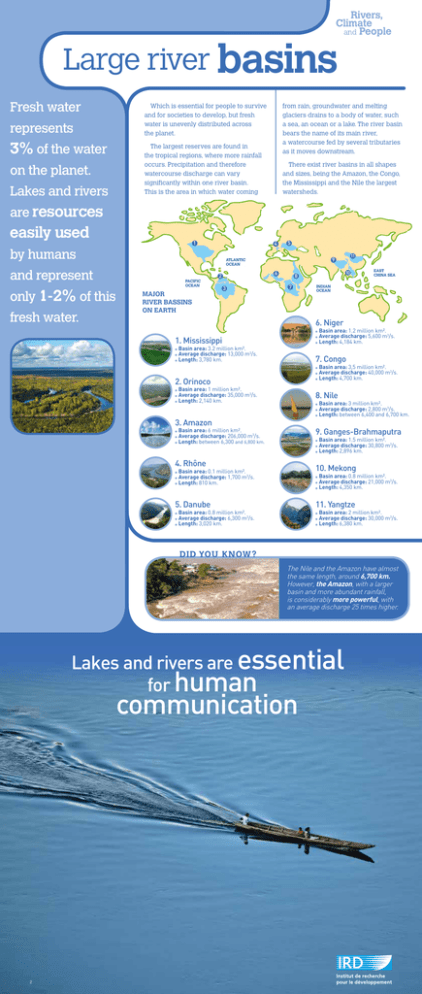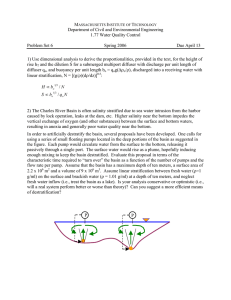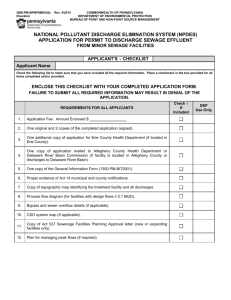Document 14089394
advertisement

Large river basins Fresh water represents 3% of the water on the planet. Lakes and rivers from rain, groundwater and melting glaciers drains to a body of water, such a sea, an ocean or a lake. The river basin bears the name of its main river, a watercourse fed by several tributaries as it moves downstream. Which is essential for people to survive and for societies to develop, but fresh water is unevenly distributed across the planet. The largest reserves are found in the tropical regions, where more rainfall occurs. Precipitation and therefore watercourse discharge can vary significantly within one river basin. This is the area in which water coming There exist river basins in all shapes and sizes, being the Amazon, the Congo, the Mississippi and the Nile the largest watersheds. are resources easily used 1 4 by humans and represent only 1-2% of this fresh water. 5 PACIFIC OCEAN 6 2 MAJOR RIVER BASSINS ON EARTH 3 11 9 ATLANTIC OCEAN 10 8 7 EAST CHINA SEA INDIAN OCEAN 6. Niger Basin area: 1.2 million km². Average discharge: 5,600 m3/s. Length: 4,184 km. 1. Mississippi Basin area: 3.2 million km². Average discharge: 13,000 m3/s. Length: 3,780 km. 7. Congo Basin area: 3,5 million km². Average discharge: 40,000 m3/s. Length: 4,700 km. 2. Orinoco Basin area: 1 million km². Average discharge: 35,000 m3/s. Length: 2,140 km. 8. Nile Basin area: 3 million km². Average discharge: 2,800 m3/s. Length: between 6,400 and 6,700 km. 3. Amazon 9. Ganges-Brahmaputra Basin area: 6 million km². Average discharge: 206,000 m3/s. Length: between 6,300 and 6,800 km. Basin area: 1.5 million km². Average discharge: 30,800 m3/s. Length: 2,896 km. 4. Rhône 10. Mekong Basin area: 0.1 million km². Average discharge: 1,700 m3/s. Length: 810 km. Basin area: 0.8 million km². Average discharge: 21,000 m3/s. Length: 4,350 km. 5. Danube 11. Yangtze Basin area: 0.8 million km². Average discharge: 6,300 m3/s. Length: 3,020 km. Basin area: 2 million km². Average discharge: 30,000 m3/s. Length: 6,380 km. DID YOU KNOW? The Nile and the Amazon have almost the same length, around 6,700 km. However, the Amazon, with a larger basin and more abundant rainfall, is considerably more powerful, with an average discharge 25 times higher. Lakes and rivers are essential for human communication 2 Changing rivers Rivers are not fixed in time and space. There are subtle links between watercourses and the reliefs in which Water always flows down the steepest slope. Therefore a river’s natural flow is linked to the topography, which in turn constitutes the legacy of the basin’s geological history. But water creates landscapes, by dissolving rocks and transporting them downstream in the watercourse. As a result rocks, pebbles, sand and silt produced by this erosion are deposited and build up on the river bed and banks, disturbing and diverting the river’s flow. Extreme climate events, such as drought or heavy Ecuador rainfall, accelerate erosion and thus increase transport of material affecting as a consequence the watercourses. Since the 19th century, humans have changed rivers significantly. These changes reroute branches, alter banks, reduce and disturb the river flows, create reservoirs, alter water flows and disrupt the wildlife living within the watercourses. But they also bring benefits to people supplying water to the towns and fields, producing energy, creating leisure areas, etc. Spain France they evolve. But they have been profoundly and rapidly affected by the climate change, and significantly The Pastaza River valley. A torrential in steep mountainous regions and becomes wider, deeper and slower downstream in the lowlands. Aldeadávila Dam. Reservoirs created by dams are used to provide towns and cities with water and energy and to irrigate fields. Many projects for large dams on tropical rivers have been planned. Bolivia Thermal (or nuclear) power plants use rivers for cooling. The subsequent increase of the water temperature by 2 to 3 °C disrupts river ecosystems. Morocco Russia by the changes made by humans over the last 200 years. A glacier on the Huayna Potosí Mountain. The Glaciers in Colombia, Ecuador, Peru and Bolivia that feed the Andean watercourses have been reduced from 30% to 50% since the late 70s confirming the acceleration of climate change at the end of the 20th century in this part of the world. River Lena. When a river is divided into several channels, some are only fed during floods, while others are cut off from the river for ever, but still contain water and have a rich biodiversity. The effects of climate change vary over time, experiencing extreme drought in one year and heavy flooding the next, but they also vary in space, with lack of rain in one area and at the same time heavy rains in another. DID YOU KNOW? Some rivers have been evolving for millions of years making impressive changes to landscapes, digging their beds deep into the rock; as is the case of the Colorado River in the United States which has been ‘sculpting’ the Grand Canyon for 7 million years. The meanders evolve as a result of erosion and sedimentation caused by the current 3 Global warming: the facts According to the IPCC*, the Earth’s average temperature Without quick and effective changes to greenhouse gas emissions, the global temperature will undergo an average increase of 3.7°C to 4.8°C by 2100. The international community’s aim is to do all it can to limit this increase to 2°C, a challenge considered as possible according to the experts. The consequences of increasing the average temperature are multiple. They include changes to rainfall patterns, with more frequent extreme events, both extreme rainfall and drought, causing floods and severe low water levels in practically all major river basins in both temperate and tropical regions. since 1880 has increased by 0.85°C. It is «extremely likely» that most CO2 is by far the most problematic greenhouse gas, accounting for 76% of emissions. Its principal sources are energy production, agriculture, industry and transportation. Industry has grown enormously since 1950, and the corresponding temperature increase is the largest ever recorded: +0.6°C. If we look at Earth’s average temperature, there is only a 5°C difference between ice ages and warm periods, when polar ice caps were almost no existed. of this increase is due to human activities**. Intergovernmental Panel on Climate Change. * ** 2013-2014 report. If the greenhouse gas effect is not reduced by at least 40% by 2050, scientists predict serious consequences. Based on the worst case scenario, in India and in Bangladesh, the monsoon rains causing floods, will increase approximately 20% in 2100, and a century later more than 50 %. On the other hand, the Mediterranean basin, the Sahel, Southern Africa and a part of the Amazon region the rainfall will decrease 10% to 20% in 2100, and even more than 50% by 2200. In France, climate change could reduce watercourse discharge from 20% to 30% by 2050, with longer and more frequent droughts. DID YOU KNOW? Under the +4.8°C scenario, rivers, lakes and wetland areas will be adversely affected by the full force of climate change. Reduced water supplies would lead to further competition between the four main uses of water: domestic, agricultural, industrial and environmental. Desertification threatens 40% of the planet’s land surface, affecting 110 countries, particularly in Asia and Africa 4






